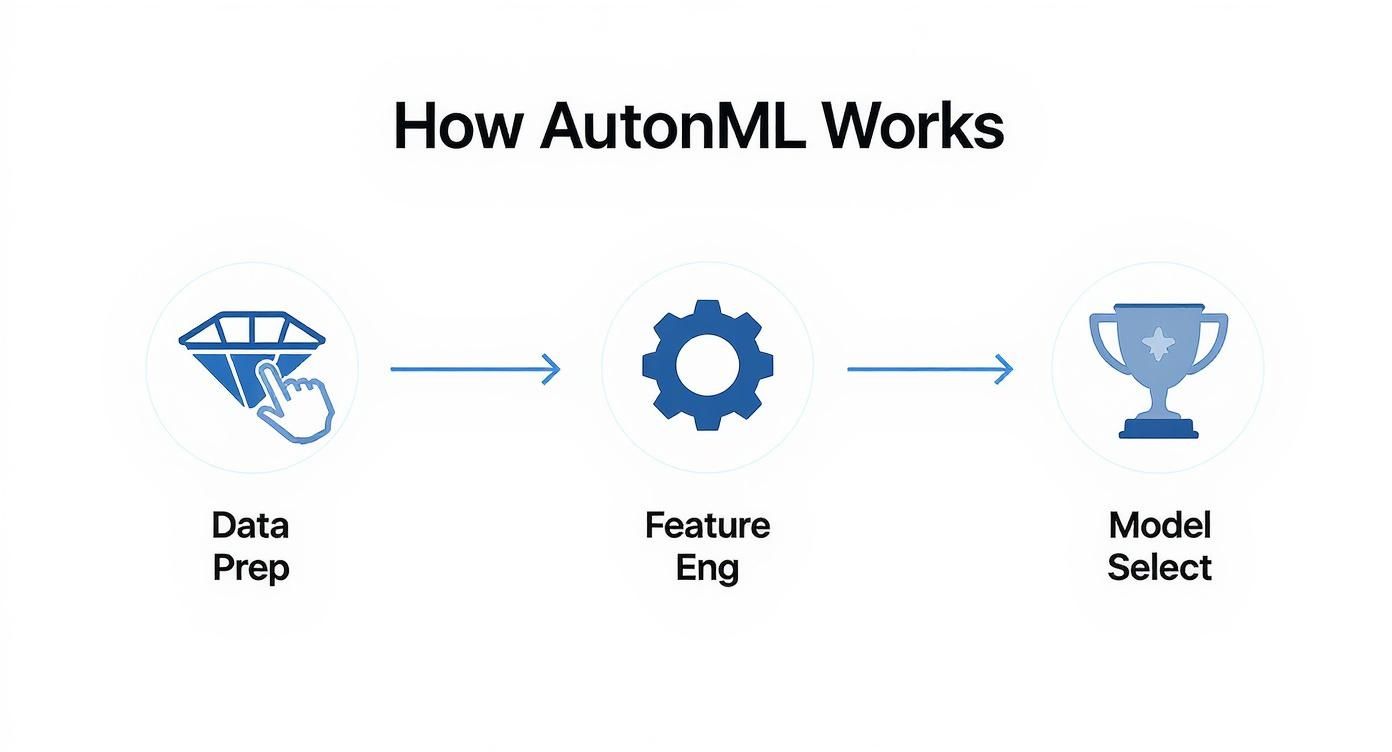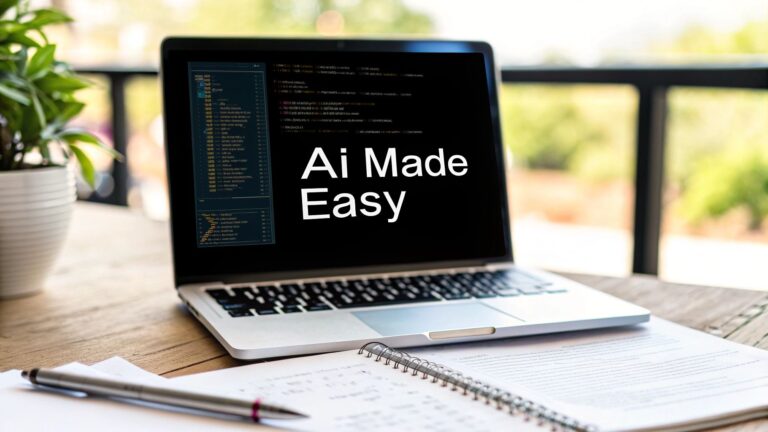Automating Machine Learning: A Practical Guide for Beginners
If you've ever felt like building an AI model is a complex, time-consuming puzzle reserved only for Ph.D.s, you're not alone. The traditional process is notoriously difficult. But what if you had a brilliant assistant to handle the most tedious and repetitive parts for you? That's the core idea behind AutoML, or automated machine learning, and this guide is here to make it friendly and easy to understand.
What Is Automating Machine Learning?

Imagine trying to bake the perfect cake from scratch without a recipe. You’d have to guess the right amount of flour, figure out how many eggs to use, and then spend hours tweaking the oven temperature to get it just right. It's a slow, painstaking process that demands a ton of experience.
Building a machine learning model the old-fashioned way is strikingly similar. A data scientist has to manually clean the data, create meaningful features, pick the right algorithm out of hundreds, and then meticulously fine-tune its settings (called hyperparameters). This can easily take weeks, if not months, of work from highly specialized experts.
Simplifying a Complex Process
AutoML completely changes the game by automating that entire workflow. Instead of a person manually cycling through each step, an AutoML platform systematically runs through thousands of possibilities on its own. It intelligently tests different algorithms and tunes their settings, automatically homing in on the best model for your specific data and goal.
This automation opens up the world of AI to a much wider audience. Suddenly, you don't need a deep background in statistics or coding to build something powerful. Business analysts, marketers, and startup founders can now build their own predictive models to drive better decisions.
"Think of AutoML not as a replacement for data scientists, but as a force multiplier. It automates the tedious 80% of the work, freeing up human experts to focus on the creative 20%—like defining the business problem and interpreting the results." – AI Industry Expert
Let's say a small e-commerce shop owner wants to predict which customers might be about to leave. Using an AutoML tool, they can simply upload their sales history, define the goal ("predict customer churn"), and let the platform handle the heavy lifting. Within hours, they can have a high-quality predictive model ready to go, all without writing a single line of code.
Who Benefits from AutoML?
The real beauty of automating machine learning is how broadly useful it is. It helps both novices get started and seasoned pros move faster.
Here’s a quick look at who benefits the most:
- Business Professionals: People without a technical background can finally build their own models to forecast sales, understand customer feedback, or spot emerging market trends.
- Data Scientists: Experts get a massive productivity boost. They can automate the grunt work, allowing them to prototype ideas much faster and focus on the more strategic, high-impact parts of their job.
- Developers: Software engineers can embed predictive features directly into their apps without first needing to become machine learning specialists.
At its heart, AutoML is about making AI more accessible. It's taking the incredible power of machine learning out of the ivory tower and putting it into the hands of anyone with a problem to solve. It doesn't remove the human from the equation—it empowers them.
How Does Automated Machine Learning Actually Work?
To really get why automated machine learning is such a big deal, it helps to peek under the hood. While the results can feel a bit like magic, it’s really just a smart, systematic process that automates the logical steps a human expert would take—saving them a massive amount of time.
Think of it like a highly efficient assembly line. You feed raw data in one end, and a polished, high-performing predictive model comes out the other.
This assembly line is what we call the machine learning pipeline, and AutoML’s job is to run that pipeline for you. The incredible value of this automation is fueling some serious growth; the global AutoML market is on track to hit USD 51.63 billion by 2033. The demand for faster, more accessible AI is pushing this technology forward. You can dig into the market trends and drivers to see just how fast this space is moving.
So, let's walk through the four core stages of this automated pipeline to see how it all fits together.
Stage 1: Data Preprocessing
Before a machine can learn anything, the data has to be clean, organized, and in a format it can understand. This stage is notoriously tedious and often eats up to 80% of a data scientist's time. It’s the unglamorous but absolutely essential foundation of any ML project.
It’s a bit like preparing a complex recipe. Imagine your ingredients are a mess—some are dirty, others are unlabeled, and a few are missing entirely. Before you can even think about cooking, you have to wash the veggies, sort the spices, and measure everything precisely. Data preprocessing is the exact same concept, just for data.
AutoML platforms handle these chores automatically:
- Handling Missing Values: If some data is missing, the system intelligently decides whether to fill in the gaps or remove the incomplete records. For example, if a customer's age is missing, it might fill it with the average age of all customers.
- Formatting Data: It standardizes everything, making sure all dates, numbers, and text follow a consistent format.
- Cleaning Noisy Data: The system spots and corrects obvious errors, like typos or impossible values (like an age of "200") in your dataset.
By automating this grunt work, AutoML ensures your model is built on a solid, reliable foundation.
Stage 2: Feature Engineering
With the data clean, the next job is to figure out which pieces of information are most useful for making predictions. This is feature engineering—a blend of art and science that can make or break a model’s performance.
Think of a master chef creating a signature dish. They know that combining a pinch of sea salt with caramel will elevate the flavor, while a beginner might just toss in random spices. In the same way, feature engineering involves selecting, combining, and transforming data variables (features) to create the strongest possible signals for the model.
For example, if you’re trying to predict house prices, "number of bedrooms" and "square footage" are good standalone features. But a new, combined feature like "price per square foot" could be an even more powerful predictor. An AutoML platform will automatically experiment with thousands of these combinations to find the ones that have the most impact.
A seasoned data scientist might brainstorm a few dozen clever features. An AutoML system, on the other hand, can test thousands or even millions of possibilities in a fraction of the time, often uncovering predictive patterns a human might never think to look for.
Stage 3: Model Selection
Now that we have clean data and powerful features, it's time to pick the right algorithm, or model, for the task. There are hundreds of model types out there, each with its own strengths and weaknesses. It's like choosing the right tool for a job—you wouldn't use a sledgehammer to drive a nail.
Typically, a data scientist uses their experience and a bit of intuition to select a handful of promising models to test. AutoML takes a more exhaustive—and effective—approach. It systematically trains and evaluates dozens of different models from various families, including:
- Linear Models (like Logistic Regression)
- Tree-based Models (like Random Forest and Gradient Boosting)
- Neural Networks
The platform essentially runs a tournament, pitting all these models against each other using your data. It then ranks them based on key metrics like accuracy or precision, identifying the top performers for your specific goal.
Stage 4: Hyperparameter Tuning
We're almost there. Once the winning model has been chosen, it needs one last round of fine-tuning to squeeze out every last drop of performance. Every model comes with a set of internal controls—think of them as knobs and dials—called hyperparameters. These settings dictate how the model learns.
Imagine you've picked a race car (the model). To get the fastest possible lap time, you still need to adjust the tire pressure, tweak the suspension, and calibrate the engine timing (the hyperparameters). Finding that perfect combination manually is an incredibly slow and painstaking process of trial and error.
This is where AutoML truly shines. Using sophisticated search algorithms, it automatically tests hundreds or even thousands of different hyperparameter combinations. This process, known as hyperparameter optimization, guarantees that the final model isn't just a good one—it's the best possible version of itself, perfectly tuned for your specific problem.
To put it all into perspective, here’s a quick comparison of how the traditional, manual process stacks up against the automated approach.
Traditional ML vs. Automated ML: A Quick Comparison
This table highlights the key differences between the manual, traditional machine learning process and the streamlined, automated approach of AutoML.
| Task | Traditional Machine Learning (Manual) | Automated Machine Learning (AutoML) |
|---|---|---|
| Data Preprocessing | Manual cleaning and formatting; very time-consuming. | Automated detection and handling of missing values, errors, and formatting. |
| Feature Engineering | Relies on domain expertise and manual experimentation. | Automatic creation and selection of thousands of feature combinations. |
| Model Selection | Based on experience; a few models are tested manually. | Systematic competition among dozens of different models to find the best fit. |
| Hyperparameter Tuning | A manual, slow process of trial and error. | Automated optimization to find the best settings for peak performance. |
| Time Required | Weeks or months. | Hours or days. |
| Expertise Required | Deep knowledge of data science and coding is essential. | Accessible to business analysts and developers with less specialized expertise. |
As you can see, AutoML doesn't just make the process faster; it makes it more thorough and accessible, freeing up experts to focus on the bigger picture instead of getting bogged down in repetitive tasks.
Why AutoML Is a Game Changer for Businesses
Automated machine learning isn't just another tech upgrade—it's a complete reimagining of how companies can solve problems and find new opportunities. It tackles the biggest bottlenecks in the AI development pipeline, turning machine learning from a niche, research-heavy function into a practical tool for everyday business.
This shift is building some serious momentum. The AutoML market is expected to explode, reaching an incredible USD 61.23 billion by 2033 on the back of a 38.0% annual growth rate. This isn't just hype; it's driven by a real need for companies to quickly spot patterns in their data and make decisions with confidence. You can get the full story on the trends pushing this market forward.
Let's dig into the core benefits that are making AutoML so essential.
Boosting Team Productivity and Speed
In machine learning, time is your most valuable resource. The traditional way of building a model can drag on for weeks, sometimes months. It’s a painstaking cycle of an expert manually cleaning data, engineering features, and testing countless algorithm combinations. This slow, repetitive process puts a hard limit on how many ideas a team can even explore.
AutoML completely shatters that barrier. It empowers teams to build and experiment with hundreds of models in the time it used to take to build just one or two. That means you get faster answers to critical business questions, deploy valuable solutions sooner, and can iterate on ideas with a level of agility that was previously unthinkable.
The visual below shows just how streamlined this process becomes, from preparing the raw data to picking the winning model.

This automated pipeline frees up your team from tedious manual work, letting them focus on strategy and solving bigger problems.
Making AI Accessible to Everyone
Maybe the biggest win for AutoML is that it puts AI into the hands of more people. For years, machine learning was locked away, accessible only to data scientists with deep coding and statistical knowledge. This created a huge talent gap, leaving most businesses sitting on a mountain of data they couldn't use.
AutoML flips the script. With intuitive, often code-free interfaces, professionals from any department can start building powerful predictive models.
- A marketer can build a model to predict which customers are likely to churn, all without writing a line of Python.
- A financial analyst can forecast sales trends using a simple drag-and-drop tool.
- An operations manager can optimize inventory levels without needing a Ph.D. in statistics.
This is a huge deal. It empowers the people who know the business inside and out—the domain experts—to apply machine learning directly to their most pressing challenges. Check out our guide on machine learning in business to see more of these applications in action.
Reducing Human Error and Bias
Building a model manually is a complex process with countless steps where small mistakes can have big consequences. One tiny error in data cleaning or a poorly chosen hyperparameter can throw off the entire model, leading to flawed predictions and bad business outcomes.
By automating the pipeline, AutoML introduces a level of consistency and discipline that's tough to match by hand. Its systematic approach minimizes the risk of human error. On top of that, many platforms now come with built-in checks to help spot and reduce potential bias in the data, which ultimately leads to fairer and more dependable models.
“AutoML is the great equalizer. It gives small and mid-sized businesses the same predictive power that was once reserved for tech giants with massive data science teams. It’s about leveraging technology to compete on intelligence, not just resources.” – Sarah Chen, AI Strategy Consultant
Delivering Significant Cost Savings
Let's be honest: hiring a team of experienced data scientists is a major investment. AutoML offers a much more cost-effective path by automating the most time-consuming and resource-heavy tasks. This isn't about replacing experts; it's about making them vastly more efficient.
The savings stack up in a few key areas:
- Reduced Labor Costs: When you automate the grunt work, smaller teams can accomplish a whole lot more.
- Faster Time-to-Value: Getting models into production quicker means you start seeing a return on your investment sooner.
- Lower Infrastructure Overhead: Many AutoML platforms are smart about optimizing computing resources, preventing you from overspending on cloud costs.
By lowering both the financial and technical barriers to entry, AutoML makes it possible for just about any organization to start building a smarter, data-driven future.
A Look at the Top AutoML Platforms
So, you're sold on the idea of automating machine learning. The next logical question is, "Okay, where do I start?" The good news is that a whole ecosystem of platforms has sprung up, each designed to make this process as smooth as possible.
Think of them like different kitchens. Some are massive, industrial-grade setups perfect for large-scale production, while others are more like a home cook's well-equipped space, ideal for custom, smaller-scale projects. The right choice really hinges on your budget, technical comfort level, and what you’re trying to build.
Let's walk through some of the most popular and approachable options out there today, from the giants in cloud computing to powerful free alternatives.
The Big Three Cloud Providers
The major cloud players—Google, Microsoft, and Amazon—have all gone all-in on making machine learning accessible. A huge advantage of their AutoML tools is that they plug directly into their wider cloud ecosystems, which is a massive plus if you're already using their services for data storage or computing power.
Google Cloud AutoML
Google's platform is well-known for its clean, intuitive interface and incredibly powerful models, particularly for tasks involving images, text, and tabular data. It's built to guide you through the process from start to finish with almost no friction, making it a fantastic choice for a first-timer.
You basically just upload your dataset, tell it what you want to predict, and Google’s engine takes care of the heavy lifting behind the scenes.
As you can see, the dashboard makes it incredibly simple to kick off a new project by clearly laying out the options for different data types. It does a great job of making a complex process feel straightforward.
Microsoft Azure Machine Learning
Azure Machine Learning offers a really flexible environment that caters to a wide range of skill levels. It features a completely visual, drag-and-drop interface called the "designer," which is perfect for beginners who want to see how all the pieces of a model fit together without writing a single line of code.
- Best For: Users who love a visual workflow and need tight integration with other Microsoft products like Power BI.
- Pricing Model: Pay-as-you-go, with a pretty generous free tier to let you test the waters.
Amazon SageMaker Autopilot
As part of Amazon Web Services (AWS), SageMaker Autopilot automatically builds, trains, and tunes the best machine learning models for your specific data. One of its standout features is transparency. It doesn’t just spit out a final model; it actually shows you the code and the steps it took to get there, turning it into a fantastic learning tool.
Powerful Open-Source Options
If you'd rather have more control, want to avoid vendor lock-in, or are working on a tight budget, open-source tools are your best friend. They are completely free to use, but they do expect you to be a bit more comfortable with code and managing your own server environment.
Auto-sklearn
Built right on top of the incredibly popular scikit-learn library, Auto-sklearn is a powerful "drop-in" replacement for standard ML models. It automatically handles algorithm selection and hyperparameter tuning, and it frequently uncovers models that outperform what even experienced data scientists can build by hand.
Expert Insight: Open-source tools like Auto-sklearn are game-changers. They give individual developers and small teams access to the same sophisticated optimization techniques used by big tech companies, effectively leveling the playing field.
Tree-based Pipeline Optimization Tool (TPOT)
TPOT takes a really unique approach. It uses genetic algorithms to search for the best possible machine learning pipeline. It's almost like running a "survival of the fittest" tournament for your models, where only the strongest combinations of data-cleaning steps, feature engineering, and algorithms make it to the end.
- Best For: Python developers who want to discover novel and highly-tuned machine learning workflows.
- Pricing Model: Completely free.
Choosing Your First Platform
I get it—all these options can feel a bit overwhelming. Here’s a simple way to break it down:
- Want a simple, guided experience with minimal setup? Start with Google Cloud AutoML.
- Prefer a visual, drag-and-drop workflow? Give Microsoft Azure Machine Learning a shot.
- Want to learn the ropes as you automate? Amazon SageMaker Autopilot's transparency is perfect for you.
- Comfortable with Python and want total flexibility for free? Dive into Auto-sklearn or TPOT.
Many of these platforms are just one piece of a larger puzzle. They often work alongside other AI data analysis tools that help you prepare and understand your data before you even begin modeling. No matter which path you choose, the most important thing is to just jump in and start experimenting. The best way to learn is by doing.
Real-World Examples of AutoML in Action
Theory is great, but seeing how automating machine learning works in the real world is where it all clicks. This isn't just some niche technology anymore; it's becoming a core driver for businesses across countless industries. Let's look at a few quick stories that show how companies are using AutoML to solve very real problems and get ahead.

This trend is especially visible in North America, which has quickly become the dominant force in the AutoML market. The region holds over 46.4% of the global market share, which translates to USD 2.08 billion in revenue. The United States alone accounts for USD 1.67 billion of that figure, a testament to the heavy concentration of major tech players and serious investment in AI research. You can dig deeper into the regional breakdown of the AutoML market for more details.
Keeping Customers Happy in Retail
The Problem: An online retail company was bleeding customers. They knew churn was a problem, but they couldn't pinpoint who was about to leave until they were already gone. Their marketing team needed a way to spot these unhappy customers early and step in before it was too late.
The Simple AutoML Solution: Instead of building out a massive data science team, they turned to a no-code AutoML platform. They fed it a simple dataset with customer purchase history, website activity, and past support tickets. The goal was crystal clear: predict how likely each customer was to churn in the next 30 days.
The platform went to work, automatically cycling through hundreds of models and configurations. It quickly surfaced that "time since last purchase" and "number of abandoned carts" were huge red flags—something the team had always suspected but could never prove with data.
The Impressive Outcome: In just a few hours, they had a shockingly accurate churn prediction model. Their marketing team could now get a daily, automated list of at-risk customers and send them a personalized "we miss you" discount. This one change cut customer churn by 18% in the first quarter, saving them thousands in lost sales.
Optimizing Ad Spend in Marketing
The Problem: A digital marketing agency was managing millions in ad spend for its clients across dozens of platforms. The team felt like they were constantly guessing which ad creatives, headlines, and audiences would actually work. It was a slow, expensive process of trial and error.
The Simple AutoML Solution: The agency decided to use AutoML to predict ad performance before spending a dime. They gave the tool historical data from past campaigns—ad copy, images, audience demographics, and, most importantly, conversion rates. The mission was to build a model that could predict the click-through rate (CTR) of a new ad before it ever launched.
AutoML helps marketers move from reactive analysis to proactive prediction. Instead of just looking at which ads performed well last week, they can now forecast which ads will perform well next week, allowing for smarter, data-driven budget allocation.
The Impressive Outcome: The model became the agency's secret weapon. Before any new campaign went live, they could run dozens of ad variations through the model to see which ones had the highest probability of success. This led to a 30% improvement in overall ad campaign performance and gave them the confidence to allocate client budgets much more effectively.
Assisting Doctors in Healthcare
The Problem: A healthcare startup had a bold idea: help radiologists spot diseases in medical images faster and more accurately. The hurdle was enormous. Training an image classification model from the ground up requires world-class expertise and huge volumes of labeled data, both of which are incredibly expensive and time-consuming to get.
The Simple AutoML Solution: The team opted for a cloud-based AutoML platform designed specifically for computer vision. They uploaded a dataset of thousands of anonymized medical scans, each already labeled by expert radiologists as either "healthy" or "showing signs of disease."
The platform took care of everything:
- It automatically preprocessed and standardized all the images.
- It tested a variety of powerful neural network architectures built for image recognition.
- It then fine-tuned the best-performing model to squeeze out every last drop of accuracy.
The Impressive Outcome: The final model could classify new, unseen scans with over 95% accuracy. It wasn't designed to replace doctors but to act as a reliable "second opinion." By flagging potentially problematic scans for a closer look, it helped reduce diagnostic errors and let doctors focus their valuable time where it was needed most, dramatically speeding up the entire workflow.
How to Start Your First AutoML Project
Jumping into your first project is the best way to really grasp what automated machine learning can do. Don't aim for a perfect model right out of the gate—the real goal is to get your hands dirty and learn by doing.
Think of this as your hands-on guide, broken down into five straightforward steps to get you from an idea to a working model.
Step 1: Define a Clear Problem
First things first: what are you trying to predict? A clearly defined problem is the bedrock of any good ML project. Are you trying to forecast sales numbers for the next quarter? Or maybe you want to classify customer support tickets into categories like "urgent" or "routine"?
Start with a simple question that has a concrete, measurable answer. A great first project is predicting a yes/no outcome, like whether a customer will click on an ad (binary classification).
Step 2: Gather and Prepare Your Data
You can't build a model without data. But don't feel like you need a massive, complicated dataset. Often, a simple spreadsheet with a few hundred rows is plenty to get started.
The key is making sure the data is clean. Check for clear column headers, handle any obvious missing values, and get rid of duplicate rows. A little bit of tidying up goes a long way in building a better model.
Step 3: Choose a Beginner-Friendly Tool
Now it’s time to select your AutoML platform. As we talked about earlier, tools like Google Cloud AutoML or Microsoft Azure Machine Learning are fantastic for beginners because they offer intuitive, no-code interfaces.
These platforms walk you through the entire process. You just upload your data, tell the system which column you want to predict (your target variable), and kick off the training with a few clicks.
Step 4: Run the Process and Interpret the Results
Here comes the fun part. Once you tell the tool to start, it gets to work, automatically trying out dozens of different models and settings to find the best fit for your data. When it's finished, it will show you the top-performing model along with key metrics, like its accuracy.
Don't get too hung up on every single number at first. Your main goal here is to see if the model is generally good at making the predictions you asked it to make.
Step 5: Experiment and Iterate
Your first model is a launchpad, not a final destination. Now, see if you can make it better. What happens if you add more data? Or what if you remove a few columns that don't seem helpful? Each tweak is an experiment that teaches you more about your data and the modeling process.
"The most important part of your first AutoML project isn't achieving 99% accuracy—it's building the confidence to ask 'what if?' and having the tools to find the answer quickly. Embrace the learning process." – Dr. Michael Rivera, AI Educator
Once you've built a model you're happy with, the next step is putting it into action. Learning about machine learning model deployment is how you turn your project from an experiment into a tool that delivers real value.
Common Questions About AutoML
Even with all the excitement around automating machine learning, it's natural to have a few questions. The world of AI moves fast, and it can be tough to separate the facts from the hype. Let’s clear up some of the most common doubts people have when they're just starting out.
This section is all about giving you direct, friendly answers to help you feel more confident about what AutoML is and what it isn’t.
Will AutoML Replace Data Scientists?
Not a chance. This is probably the biggest misconception out there. Think of AutoML as a powerful assistant, not a replacement. It’s like giving a master chef a state-of-the-art food processor—it doesn't replace their skill, it just preps ingredients faster so they can focus on crafting the perfect dish.
AutoML makes data scientists more productive and valuable, not obsolete. It frees them up from the grunt work to tackle more strategic challenges, such as:
- Defining the right business problems that AI can actually solve.
- Interpreting complex model results to uncover deep, actionable insights.
- Ensuring ethical and fair AI practices are at the core of every project.
Do I Need to Code to Use AutoML?
For many of the leading platforms, the answer is a resounding no. One of the best things about AutoML is its "low-code" or "no-code" approach, which has opened the doors for so many people.
Tools from major cloud providers like Google, Microsoft, and Amazon have user-friendly graphical interfaces. You can literally upload a spreadsheet, click a few buttons to define your goal, and let the platform build, train, and tune models for you. This accessibility is what makes AutoML so special.
How Much Does AutoML Cost?
The cost can vary quite a bit, which is great because there’s an option for almost any budget. Cloud platforms typically use a pay-as-you-go model, and many have generous free tiers that are perfect for learning and running your first few projects without spending a dime.
On the other hand, powerful open-source tools like Auto-sklearn and TPOT are completely free to use. The catch is that you'll need to set up and manage your own computing environment to run them, which takes a bit more technical know-how.
Is AutoML Only for Simple Problems?
While it’s an amazing entry point for beginners, don't mistake simplicity for a lack of power. AutoML is regularly used by large enterprises for highly complex and mission-critical tasks. We’re talking about demanding jobs like real-time fraud detection, intricate supply chain forecasting, and even analyzing medical images.
It provides a strong, reliable baseline model that expert teams can then take and fine-tune for even better, more specialized performance.
At YourAI2Day, we're committed to breaking down the complexities of AI and making it accessible to everyone. Whether you're a business leader, a developer, or just curious, we have the resources to guide your journey. Check out our latest articles and tools at https://www.yourai2day.com.







